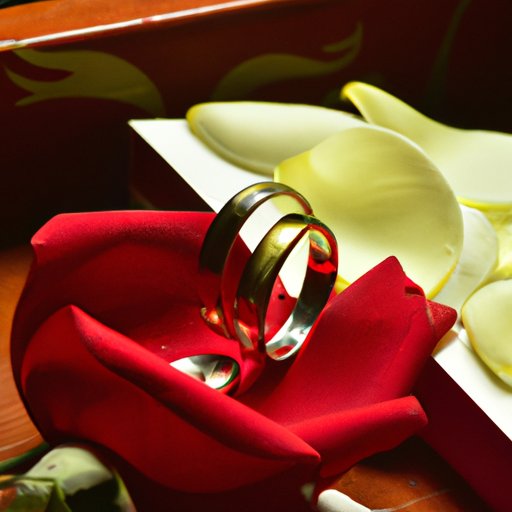Introduction
Getting engaged is an exciting milestone in any relationship, but it also comes with a long list of questions and decisions. One of the most common questions is which hand is the proper one to wear an engagement ring on. In this article, we’ll explore the cultural significance of engagement rings, their historical evolution, practical advice on choosing the correct hand, different styles of engagement rings, and the modern approach to engagement ring traditions.
The Cultural Significance
The origins of giving engagement rings have been traced back to ancient Egypt, where rings were made from woven reeds and worn on the fourth finger of the left hand, a finger believed to have a direct connection to the heart. This belief was later adopted by the ancient Greeks and Romans, who believed that the ring finger contained a vein that connected directly to the heart.
Today, many countries have their own customs on which hand to wear an engagement ring. In many Western countries, including the United States, Canada, and the United Kingdom, the engagement ring is typically worn on the left hand. In other countries, like Russia and India, the engagement ring is worn on the right hand.
The symbolism of an engagement ring is also significant. It represents love and commitment between two people, and wearing it on a specific hand adds to its meaning. Traditionally, the ring finger on the left hand is reserved for engagement and wedding rings, while the right hand is reserved for other rings, like fashion or family heirlooms.
The Historical Evolution
Engagement rings have evolved over time, with different cultures and societies having their own frameworks. For example, the ancient Egyptians used braided reeds wrapped around the finger as a symbol of eternity and intertwined love. The Greeks and Romans used rings made of precious metals, with the Romans engraving their rings with likenesses of the couple.
During medieval times in Europe, engagement rings became more elaborate and included precious gemstones. In the 1800s, diamonds were first used in engagement rings, which remained a luxury item for the wealthy for many years. It wasn’t until the 1900s that diamonds became more affordable, and the engagement ring became a cultural norm.
Different countries and regions also have their own preferences for engagement ring positioning. For example, in Lithuania, it is customary for the engagement ring to be worn on the right hand before the wedding and then moved to the left hand afterward. In Israel, the custom is to wear the engagement ring on the left hand during the engagement and then move it to the right hand at the wedding ceremony.
The Practical Advice
When it comes to choosing the correct hand for an engagement ring, the proper hand placement can vary depending on the ring style, individual preferences, lifestyle, and career. For example, left-handed individuals could experience discomfort if they wear a ring on their left hand, so they may prefer wearing it on their right hand. Additionally, individuals with an active lifestyle could have difficulty wearing a valuable ring daily and could prefer wearing it on a less-dominant hand.
Another factor to consider is combining engagement and wedding rings. If couples plan to wear their wedding band and engagement ring together, they should choose which hand to wear them on early on. Tradition dictates wearing the engagement ring closer to the heart, followed by the wedding band, but exceptions can be made depending on individual preferences. It’s essential to ensure that both rings fit comfortably together and provide a cohesive look.
Individuals should also consider their career or hobbies when choosing the hand for their engagement ring. For example, professions like chefs or surgeons could require regular hand washing, which could damage an engagement ring. Sports enthusiasts or individuals with a more active lifestyle should also consider the impact that their hobbies could have on their rings.
The Different Styles
The style of the ring can also play a role in determining which hand is appropriate. Some prefer to wear a larger rock on the hand that they don’t use much, while others prefer symmetry by wearing it on the same hand as their wedding band. Certain ring styles, like the three-stone ring, look better on a specific hand, while other styles, like the solitaire, offer more flexibility.
Despite the various styles available, personalized rings have become increasingly popular among couples. Custom designs enable couples to incorporate their preferences into their rings, with the option to choose different metals, stones, and styles. Regardless of the style, the right-hand placement can enhance the aesthetic of the ring and complement the individual’s style.
The Modern Take
Today, engagement ring traditions have become more flexible, with couples opting for unique ring styles and disregarding traditional customs. Many brides prefer to wear their engagement ring on their right hand or switch it between hands, while others choose not to wear an engagement ring at all. Some couples choose to wear matching engagement rings or opt for a more non-traditional style to reflect their personality.
The rise of non-traditional engagement rings has also opened new options for same-sex couples, with some opting for matching bands or unique designs to celebrate their engagement. The modern approach to engagement rings has inevitably challenged traditional methods, leaving more room for personalization.
Conclusion
Choosing the right hand for an engagement ring is a personal decision that should reflect individual preferences, lifestyle, and cultural customs. While tradition dictates the ring finger on the left hand for an engagement ring, different cultures and regions have their own set of customs. Ultimately, the right-hand placement should provide comfort and reflection of the individual’s style and personality.
Today, engagement ring traditions are no longer as rigid as they once were, with couples opting for more non-traditional styles to reflect their personality. Whether a couple chooses to follow the traditional placement or adopt a new style, it’s a personal decision that should reflect the individual’s personality and relationship.
